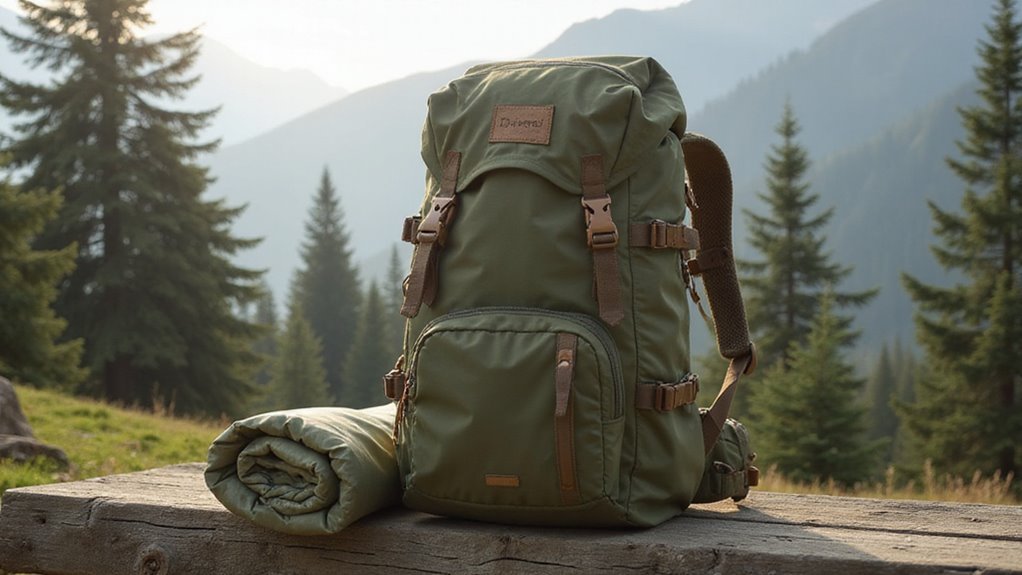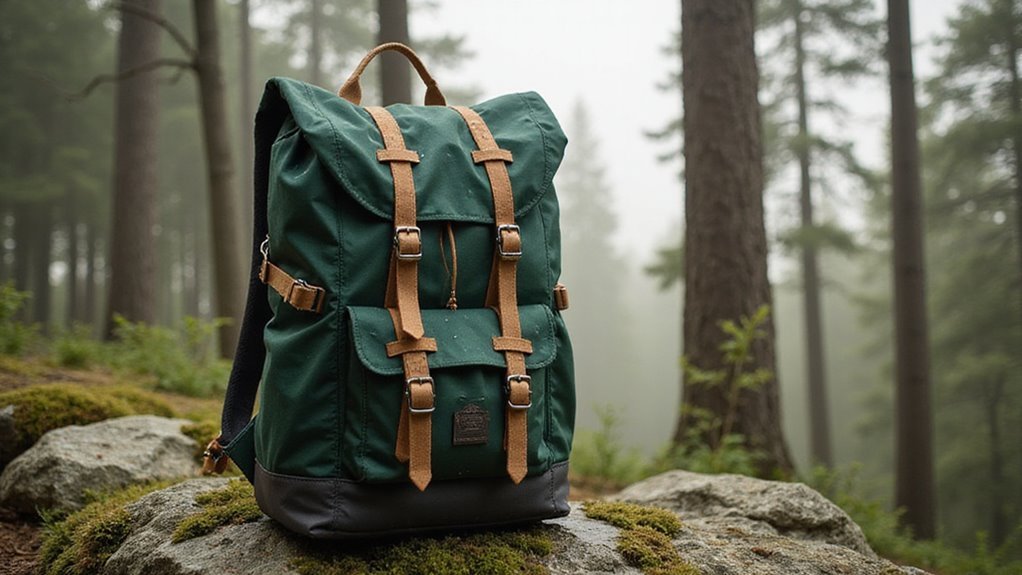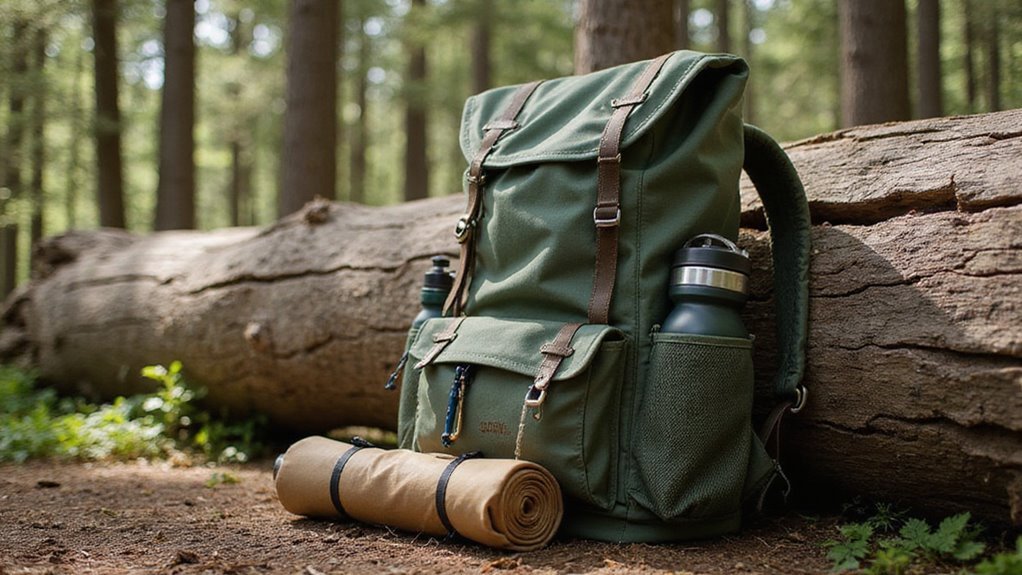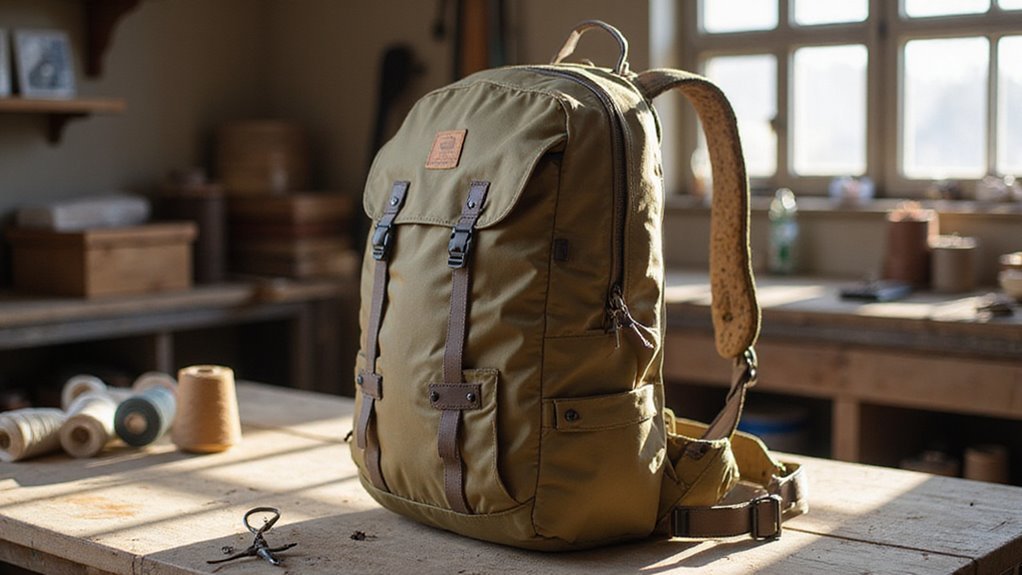We’ve reached a critical point in hiking gear evolution where sustainability can’t be separated from performance. Let’s cut through the marketing noise and get real about eco-friendly packs for long trails. Modern recycled materials and PFC-free coatings aren’t just feel-good features – they’re engineering necessities for the conscious hiker. What you’re about to discover will transform how you think about durability, comfort, and environmental impact in your gear choices.
Top-Rated Sustainable Materials in Hiking Backpacks

When it comes to sustainable hiking backpacks, we’re seeing a revolution in eco-friendly materials that don’t sacrifice performance. Leading brands are crushing it with 100% recycled fabrics, while Bluesign-approved materials slash water and energy waste.
We’re particularly stoked about PFC-free DWR treatments that keep you dry without the environmental hangover.
Here’s the kicker: these sustainable backpacks aren’t just green washing. They’re built to last with lifetime guarantees and repair services. Circular economy principles are now being integrated into design processes, ensuring that these backpacks contribute to a sustainable future.
From recycled materials to biobased innovations, today’s eco-friendly materials are proving that high performance and commitment to sustainability can coexist beautifully on the trail.
Essential Features for Long-Distance Trail Packs
Building on our sustainable materials expertise, let’s talk packs that’ll handle the long haul.
For serious trail time, we’re looking at backpacking packs with 50-70L capacity, built from recycled nylon and sustainable materials that laugh at rough conditions.
Your pack needs adjustable and padded shoulder straps plus a robust hip belt – non-negotiable for weight distribution.
We’ll insist on weather-resistant features like PFC-free coatings to keep gear dry.
Multiple compartments and pockets aren’t just convenient; they’re survival-smart.
Trust us: organization equals efficiency when you’re days deep into wilderness territory. Additionally, look for packs with integrated rain covers to protect your gear from unexpected downpours.
Weather-Resistant Eco-Conscious Design Elements

Since the planet’s health matters as much as your trek, we’ve zeroed in on weather-resistant designs that don’t compromise environmental ethics.
Modern sustainable packs leverage recycled materials and eco-conscious features without sacrificing durability or performance.
- PFC-free DWR coatings repel moisture while minimizing environmental impact
- Recycled nylon construction provides rugged weather resistance
- Bluesign-approved materials guarantee responsible manufacturing
- Reinforced seams and quality zippers extend pack lifespan
These materials they use aren’t just tough – they’re smart. Dyneema technology makes these packs some of the strongest and lightest on the market, ensuring that your gear can withstand the elements while keeping your environmental footprint light.
That’s hardcore sustainability in action.
Load Distribution and Comfort Technologies
The smartest packs don’t just carry weight – they manage it. We’ve identified core technologies that transform load distribution from burden to benefit. Modern adjustable suspension systems align with your body’s mechanics, while ergonomic designs leverage recycled materials for guilt-free comfort. Proper weight distribution is essential for preventing strain on the spine and ensuring a comfortable hike.
| Feature | Benefit |
|---|---|
| Suspension System | Customized weight balance |
| Hip Belt | Core stability control |
| Ventilated Back | Sweat reduction |
| Load Lifters | Center gravity alignment |
| Frame Design | Weight distribution optimization |
Your pack’s comfort isn’t negotiable. Smart engineering puts every ounce where it belongs – close to your body’s center, stabilized through strategic compression. That’s why we’re seeing revolutionary advances in how packs work with, not against, your natural movement.
Storage Solutions for Extended Adventures

Smart storage demands more than just cramming gear into a single compartment. When we’re selecting backpacking gear for extended adventures, we prioritize packs with strategic compartmentalization and sustainable hiking features.
Today’s storage solutions often incorporate recycled polyester ripstop and water resistance technology.
- Multi-compartment designs like the Cotopaxi Allpa 35L maximize organization
- Hybrid options such as Gregory Alpaca Duffel 60 offer versatile access points
- Adjustable systems guarantee weight distribution stays balanced on long treks
- Eco-conscious materials deliver durability without environmental compromise
- Weather-resistant materials ensure that your gear stays protected from unexpected rain and splashes.
Going lightweight doesn’t mean sacrificing functionality. Smart storage transforms hiking gear from basic containers into trail-ready command centers.
Durability Standards in Green Manufacturing
Modern durability standards in green manufacturing have revolutionized how we build and test outdoor gear.
We’re seeing sustainable backpacks made with recycled materials that match or exceed traditional pack performance. These durability standards now mandate reduced chemical use through PFC-free water treatments and strict material testing.
Look for certified brand partners using Bluesign protocols – they’re leading the charge in both quality and sustainability.
We’ve found that eco-conscious manufacturing actually helps reduce environmental impact while delivering superior strength. From reinforced stitching to bombproof buckles, today’s green gear proves that sustainability and durability aren’t mutually exclusive. Additionally, the incorporation of ripstop fabric ensures that these eco-friendly packs are not only lightweight but also exceptionally durable.
Impact-Minimizing Pack Construction Methods

While traditional pack construction often prioritizes cost over conscience, leading manufacturers have revolutionized their methods to minimize environmental impact without sacrificing quality.
We’re seeing sustainable backpacking evolve with packs made of recycled materials and ethical manufacturing practices that slash their carbon footprint.
- Bluesign-certified processes guarantee minimal chemical impact
- PFC-free water repellent treatments protect without toxins
- 100% recycled polyester and nylon construction reduces waste
- Built-in repairability guarantees long-lasting durability
- These innovations mean we’re not just getting better packs – we’re getting smarter about how they’re made while protecting our planet, prioritizing sustainable choices that benefit both adventurers and the environment.
Maintenance Tips for Long-Lasting Performance
Proper maintenance of your backpack isn’t just about cleanliness – it’s about maximizing your investment and ensuring reliable performance when you need it most.
Even durable packs made from recycled materials require regular care to maintain their water resistance and structural integrity.
We’re talking essential routines here: Inspect seams and straps after each adventure, clean with mild soap regularly, and store in cool, dry spaces away from UV rays.
Many manufacturers offer lifetime guarantees – use them. A well-maintained pack serves you longer, reducing waste and replacement costs.
Smart maintenance isn’t optional; it’s your gear’s lifeline. Checking zippers and hardware monthly is crucial to prevent unexpected failures.
Ethical Production and Fair Trade Certifications

Beyond maintaining your gear, you’ve got to contemplate who’s making it. Fair Trade certifications guarantee ethical production standards are met, supporting both workers and sustainable practices.
We’re seeing more brands commit to responsible sourcing and eco-friendly materials, transforming the backpack industry.
- Fair Trade certified brands assure fair wages and safe working conditions
- Community development initiatives empower local manufacturing hubs
- Sustainable practices include recycled materials and waste reduction
- Transparent supply chains allow tracking from source to consumer
Frequently Asked Questions
Can Eco-Friendly Hiking Packs Be Returned if They Don’t Fit Properly?
With 92% of hikers prioritizing proper fit, we’re happy to offer a 30-day return policy and fit guide. Check our customer reviews, explore sizing options, and trust our exchange process and warranty.
How Do Sustainable Backpacks Compare in Price to Conventional Hiking Packs?
We’re seeing sustainable materials increase pack prices by 15-30%, but they’re a smart long-term investment. With growing consumer trends and market growth, reputable brands are making eco-friendly options more competitive.
Are Eco-Friendly Packs Available for Children and Smaller-Framed Hikers?
Like saplings growing strong, we’re seeing more child-friendly designs with size adjustments and lightweight materials. Many brands offer sustainable, eco-certified packs that’ve passed durability tests for smaller adventurers.
What Color Options Are Available for Environmentally Conscious Hiking Backpacks?
We’re seeing eco-friendly dyes create earthy tones and vibrant options aligned with color psychology and seasonal trends. Natural materials influence brand offerings, while customer preferences drive choices between forest greens, ocean blues, and desert neutrals.
Do Sustainable Hiking Packs Qualify for Airline Carry-On Requirements?
We’ve seen millions of sustainable packs fit carry-on dimensions perfectly! Most meet airline policies and weight restrictions when packed smartly. Check pack features against your airline’s travel tips before flying.